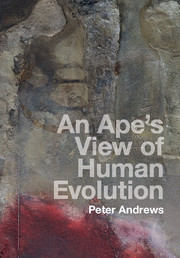Book contents
- Frontmatter
- Contents
- Preface
- 1 How can we recognize common ancestors?
- Part I Apes: their morphology and behaviour
- 2 Morphology and behaviour of living apes
- 3 Human and ape phylogenies
- 4 Review of fossil apes
- PART II Environments and palaeoenvironments
- Part III Review of fossil apes
- Part IV Last common ancestor
- References and further reading
- Index
- References
3 - Human and ape phylogenies
from Part I - Apes: their morphology and behaviour
Published online by Cambridge University Press: 05 January 2016
- Frontmatter
- Contents
- Preface
- 1 How can we recognize common ancestors?
- Part I Apes: their morphology and behaviour
- 2 Morphology and behaviour of living apes
- 3 Human and ape phylogenies
- 4 Review of fossil apes
- PART II Environments and palaeoenvironments
- Part III Review of fossil apes
- Part IV Last common ancestor
- References and further reading
- Index
- References
Summary
We have seen that the living apes share many characters with humans, and since the time of Darwin it has been generally recognized that they are our closest living relatives. Their morphology, however, does not demonstrate clearly which of the apes is our closest relative, and while the shared behaviours of chimpanzees and humans are suggestive, it is not conclusive proof of relationship. It has also been mentioned above that there is no known fossil ape that can unreservedly be shown to be ancestral of any living species of ape or human, as the evidence available from the known fossils is ambiguous, although it must be stressed that they provide much essential information on other aspects of ape evolution. The evidence for relationships comes from comparisons of living apes and humans with each other based on their morphology, behaviour and genes. It is this last line of evidence, the molecular biology of apes and humans, that will be covered in this chapter.
Morris Goodman set the application of genetic markers for human evolution on its way in the 1960s, and his book Molecular Anthropology was a landmark in primate phylogenetic studies. Goodman was very clear that humans were most closely related to African apes, but early methods lacked sufficient detail to differentiate between chimpanzees or gorillas as man's closest relative. Later work on immunological responses came to the same conclusion, but interestingly the level of responses of human with gorilla genetic markers was less than that with chimpanzee (1.09 for gorilla:human compared with 1.14 for chimpanzee:human, taking human:human as 1). For the first time, however, an attempt to put a date to the human/ape divergence was made, and assuming that immunological divergence increases at a constant rate, a date of 5 million years ago for the split was indicated. In the nearly 50 years since this figure was published, it has remained close to the centre of a range of values proposed by numerous studies, some older and some younger.
It was first proposed that chimpanzees and humans share almost 99% of their genome based on a measure of genetic distance. Almost more important than this conclusion was the observation that genetic distance did not coincide with observable morphological differences, and it was concluded from this that mutations alter the level of gene expression by modifying regulatory genes rather than changes in base pair substitutions.
- Type
- Chapter
- Information
- An Ape's View of Human Evolution , pp. 40 - 49Publisher: Cambridge University PressPrint publication year: 2016



